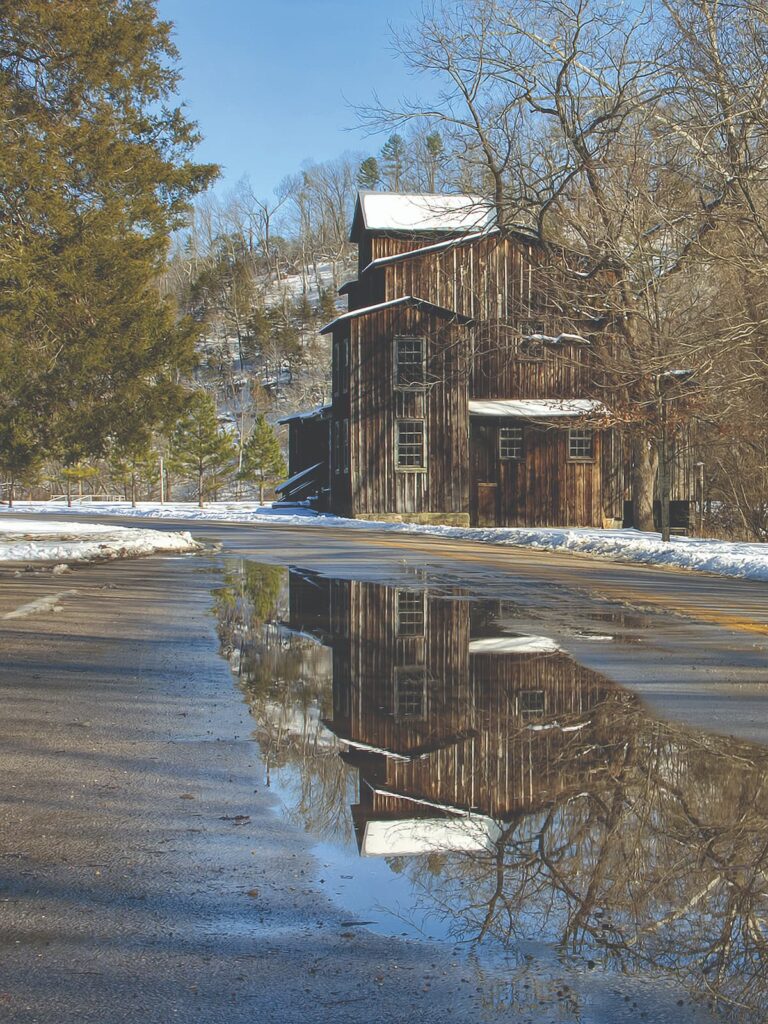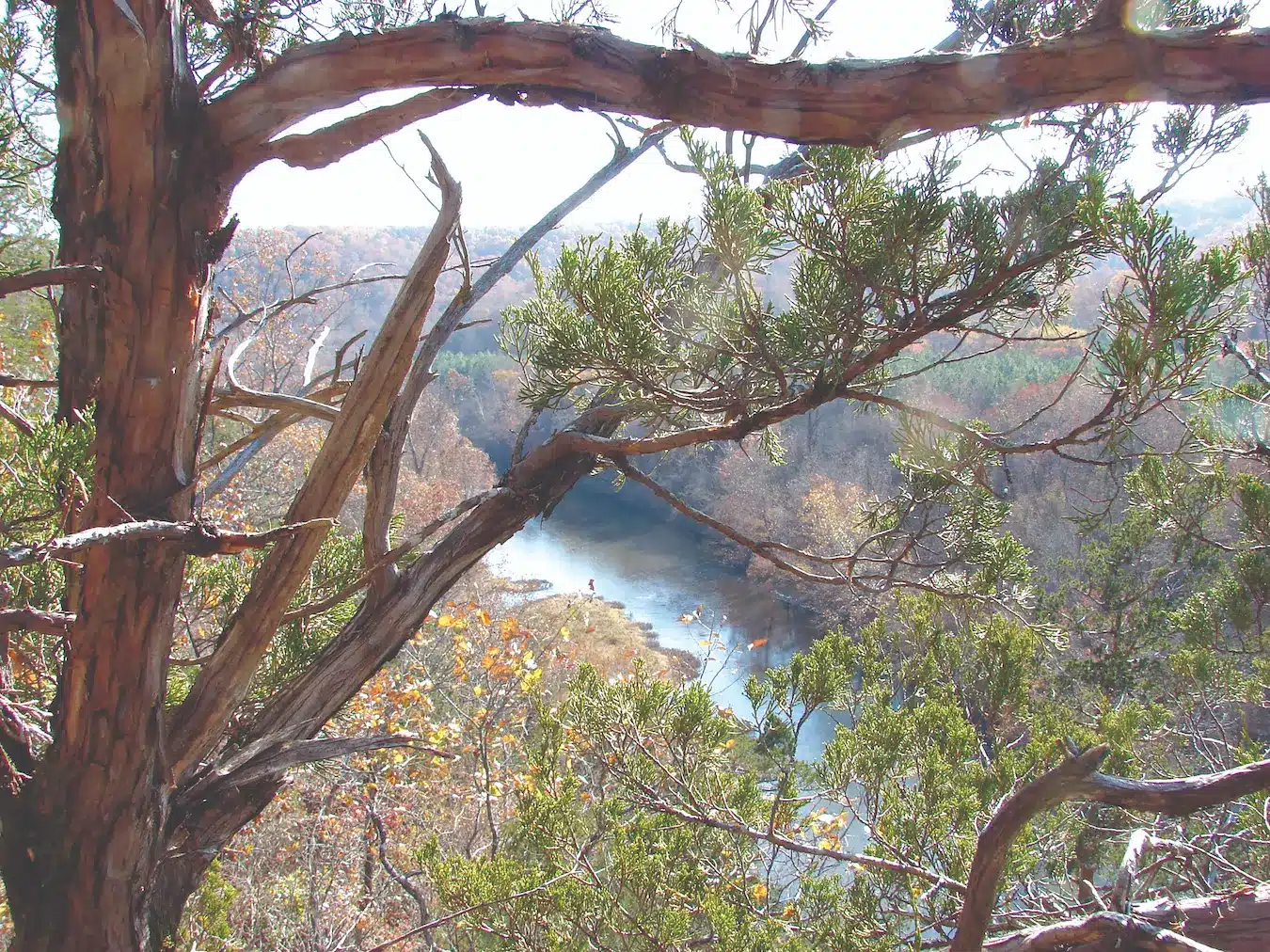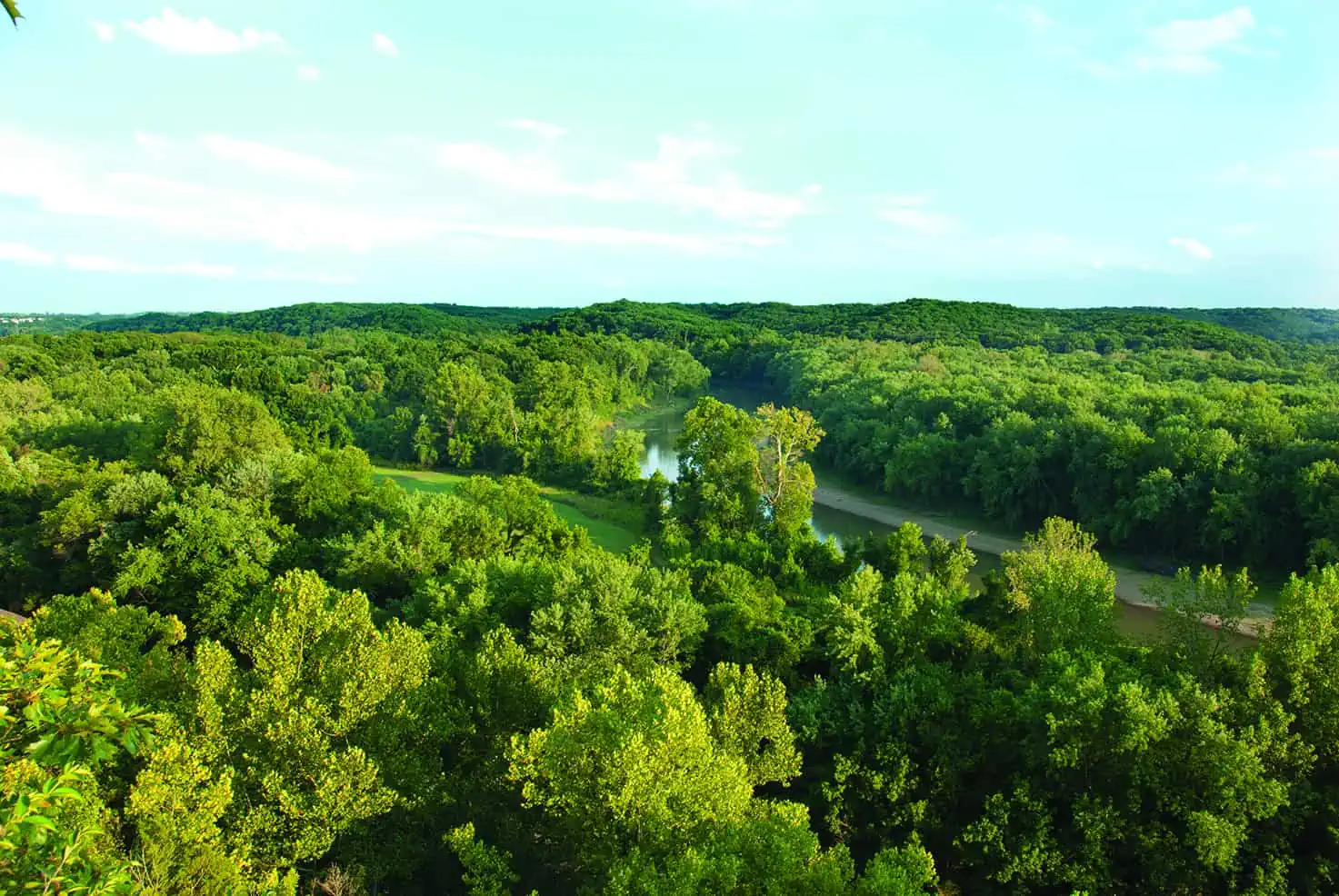Montauk State Park is one of the oldest in the Missouri State Park system. Visitors can see the headwaters that form the Current River, cast a line in a well-stocked trout run, explore a pre-Civil War mill, and maybe even spot a pair of bald eagles.

Photo by Scott Myers
Originating in a series of springs adjacent to Pigeon Creek in Dent County, the Current River begins its journey south in Montauk State Park. More than forty million gallons of cool, clear water bubble up daily from the ancient dolomites lying under this park. Many more springs add their flows to this “running river” as it hurries toward Arkansas. French settlers knew it as la rivière courante. The river twists and turns, entrenched in the hilly landscapes of the Ozarks, and its rugged beauty has made it the most popular of Missouri’s float streams. Leonard Hall, the dean of Missouri’s conservation writers, put it best: “One thing which makes Current River unique is that it lives out its entire life within the heart of the Ozark high land and thus is always in character.”
The National Park Service manages much of the Current River as part of the Ozark National Scenic Riverways. Established in 1964, the Riverways, comprised of the Current River and its tributary, the Jacks Fork, marked the first attempt by the federal government to create a linear river park. Three of the oldest and most popular Missouri state parks—Big Spring, Alley Spring, and Round Spring—were ceded to the new federal Riverways. But Montauk, where the river is born, remains a state park.

Photo by Oliver Schuchard
One of the first-generation of parks, acquired by the state in 1926, Montauk is perhaps best known as one of Missouri’s four trout parks. Two others, Bennett Spring and Roaring River, are also in the state park system, while Maramec Spring is managed by a charitable foundation. The secluded setting has over three miles of fishing stream and stunning woodlands that surround the spring branch, which give Montauk a more primitive feel than the state’s other trout parks. The long, cold spring branches of Montauk provide an ideal habitat for hatchery-bred rainbow trout. The Civilian Conservation Corps (CCC) constructed the handmade stone dam and spillway that control the outflow of water from the rearing ponds in 1935. As at Bennett Spring, the CCC company at Montauk was composed of veterans of World War I, including several experienced stonemasons. The rustic character of the stonework, which gives the impression of a natural formation rather than a man-made feature, has merited its inclusion on the National Register of Historic Places.
Almost any weekend from early spring to late fall, anglers from Missouri and other states flock to the park and line up along the “runs,” trying to catch one of the delectable beauties released to the wild every day by the Missouri Department of Conservation, which manages the fishery. The most extraordinary spectacle is the old-fashioned trout opening-day ritual on March 1 each year. Thousands of ardent anglers descend on the park the day before, and some stay up all night visiting with friends and readying equipment, the better to jockey for position in the cold dawn as they wait for the opening siren. It used to be mainly a male-bonding ritual, with young boys proudly accompanying their fathers to their first opening, but nowadays there are many mothers and grandmothers fishing alongside young boys and girls. Surely one of the most colorful events, opening day at the trout parks has come to signal the beginning of a new year for the entire park system.
Rising from the springs and hatchery area, steep wooded ridges hem in the fledgling Current River, forming a narrow valley of superb, scenic beauty. The slopes are covered with a mature woodland of white oak,shortleaf pine, black oak, northern red oak, and maple. In places, the river flows below tall pine-capped bluffs of stained dolomite. The park is well known for its spring wildflower display—the fire pinks, blue phlox, white and yellow dogtooth violets, yellow bellwort, Solomon’s seal, trillium, columbine—and, of course, flowering dogwood, wild plum, serviceberry, and redbud. Beginning in the late 1990s, park staff initiated ecosystem restoration efforts involving prescribed fire in the heart of the high quality woodlands at Montauk. Successive fires have opened the understory to reveal woodland wildflowers, such as the spectacular royal catchfly, which regularly appeared throughout this part of the Current River Hills before European settlement and now flourishes again.
Montauk Spring today really consists of multiple springs, but back before the turn of the twentieth century, there was a single big spring outlet. Legend says someone made a sounding that proved that spring to be at least 250 feet deep. Then in 1892, a torrential local downpour in Crabtree Hollow washed sand, gravel, and debris into the spring. The filled spring reportedly belched for several days before the bubbling water formed the multiple springs we see now. No doubt it was the presence of the spring that attracted the first white settlers to the valley, not far into the nineteenth century. Most of the settlers were from Kentucky or Tennessee, although settlers from New York named the village of Montauk, which was the second town established in Dent County.

Photo by Dave Dawson
The rushing waters from Montauk Spring were ideally suited to powering gristmills, and the little valley was home to four different mills. The first was built in 1835 and operated by A. W. Hollerman. Twenty-five years later, the Stephenson family built and operated both a gristmill and restored the 1896 mill and set into the new stone foundation two old buhrstones filled with concrete. In the center of one is the inscription: “Veteran Co. 1770 Sec. 2 Feb. 10, 35.” The company also built roads, cabins, foot trails, and shelter houses.
The mill, the last remnant of the once thriving village of Montauk, is now open to the public. Much of its machinery is still intact, although the steel rollers were removed in 1942 for the war effort. When the mill was operating, bucket elevators moved the grain to a bin at the top of the mill. Then the grain dropped through many pairs of horizontal steel rollers, which crushed it. As it passed between each pair of rollers, vibrating silken screens called bolts sieved the grain. So the wheat passed from roller to roller, becoming finer and finer, and the bolts sifted the wheat, separating it from the bran and removing impurities. On the main floor, workers sacked the flour, middlings, shorts, and bran. Over the years, the state has undertaken further restoration of the mill and the mill store.

Photo by Larry Sportsman
The 2,100-acre Montauk State Park offers a variety of accommodations: campgrounds, housekeeping cabins, a motel, and the Dorman L. Steelman Lodge. The facilities are open year-round, and a meeting room is available for small conferences. During the winter months, catch-and-release angling is available. During the regular fishing season, there are trout derbies and mill tours, hikes, and amphitheater programs led by interpreters. Montauk is popular, having the highest occupancy rates for its campgrounds and lodgings of any state park.
That is no surprise, given the allure of the trout fishing, the mill, the headwaters of the Current River, and the well-developed trail system here. Opening day or any day, Montauk State Park is a treasure. Even the eagles like it here at the gateway to the Current River.

MONTAUK STATE PARK • 345 COUNTY ROAD 6670, SALEM MO
Feature image by Larry Sportsman.
Related Posts
The Diverse Current River State Park
The richly diverse Current River State Park has almost two miles of Current River frontage and a superb trail network. The fishing is abundant and a lazy float down the Current River is a perfect way to spend any day of the week.
Take a Trip to Cuivre River State Park
At Cuivre River State Park you can take in the sweeping views, set up camp, go swimming and fishing, and visit American Indian campsites and burail grounds. Spend some time at Lincoln Hills Natural Area–the park’s crown jewel.
Castlewood State Park
Castlewood State Park has more than thirty miles of hiking and biking trails, eleven of which are open to horseback riders. Experience the feel of a mature floodplain forest with its silver maple, box elder, black willow, white ash, sycamore, slippery elm, and hackberry. Bring a picnic and enjoy the beauty of this park.
Ron Marr on Zen and the Art of Catfishing
Ten years ago, Missouri Life columnist Ron Marr filled us in on the zen of catfishing. He muses on the rules of flyfishing and why he finds catfishing more to his liking. Find why Ron knows there is more to catfishing than meets the eye..




